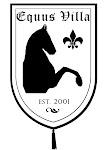
The stirrup is a ring with a flat bottom, usually hung from each side of a saddle to create a footrest for the rider on a horse or, much less often, another animal. It greatly increases the rider's ability to control the horse, making this animal a useful tool in communication, transportation and warfare. As a result it is considered one of the basic tools used to create and spread modern civilization. Some even argue it is as important as the wheel or printing press. The stirrup was invented surprisingly late in history, considering that horses were used for bareback riding and to pull carts or war chariots since at least 10,000 B.C.
The stirrup was apparently invented in China in the first few centuries A.D., but there is some evidence that stirrups may have been used in Assyria as early as 850 B.C. and was spread throughout Eurasia by the great horsemen of the central Asia steppes, such as the Mongol empire. In 580 AD a military manual of the Byzantine emperor mentions the need for stirrups. By 600 AD, the Avars had been pushed west from the Steppes by the Turks, introducing the stirrup to Europe.
Documentation for the first stirrups in Europe is vague, but they may have been used as early as the 8th century by Charles Martel (Charles the Hammer). Many have argued for the use of the stirrup by the German Carolingians, but it was not likely in general use in Europe before the 8th or 9th century. Some historians (notably Lynn White in 1962) have advanced theories that the entire development of Feudalism in medieval Europe ( with overlords and knights ruling over a peasant class) was based on the invention of the stirrup. With a stirrup, a knight could sit back in the saddle with feet in the stirrup, put a lance under his arm and drive a spear into the enemy. At that point, the weight, the speed and the power of the horse becomes part of the cavalry armament - used as an element of shock. Others argue that calvary on saddles with high pommel and cantle (back support aiding the rider to stay in the saddle) would have allowed lancers sufficient control without the necessity of stirrups.



1 comment:
Interesting post! Thanks for sharing!
Post a Comment